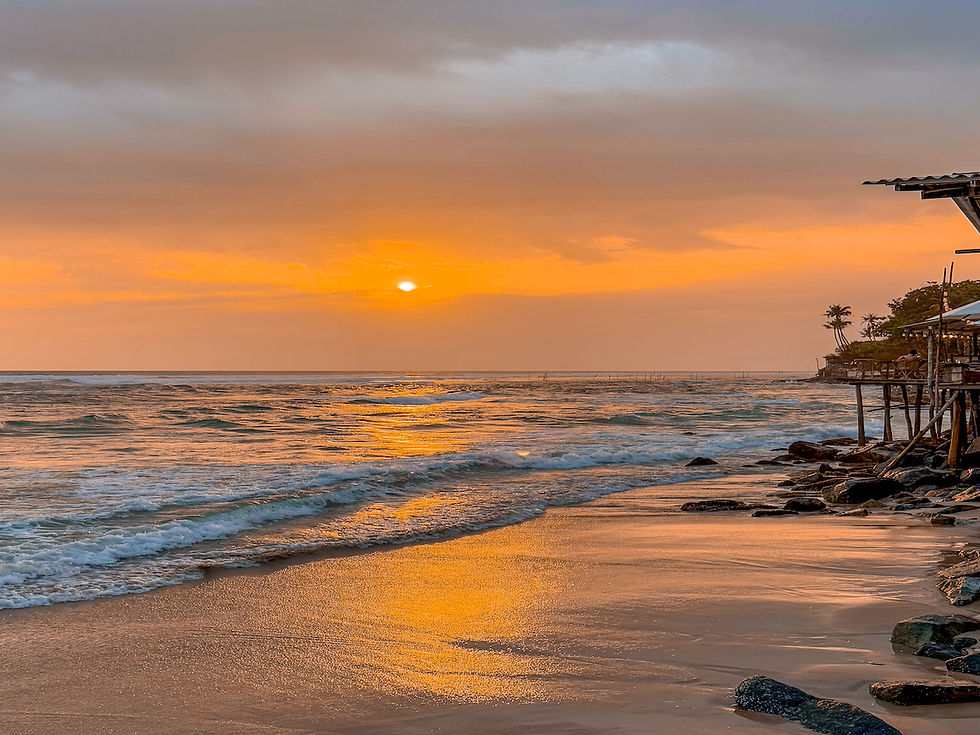Ahangama Has Quietly Evolved Into The Creative Capital Of Coastal Sri Lanka
- Zara Abeywardena

- Aug 19
- 4 min read
Updated: Oct 15

Once a sleepy fishing village tucked between Galle and Matara, Ahangama has transformed into one of Sri Lanka’s most compelling microcosms of modern island life. Its rise over the past decade has been quiet yet seismic, driven not by top down development but by a patchwork of independent creators, wellness entrepreneurs, and returning diaspora who have turned this unassuming stretch of coast into a magnet for a global crowd seeking more than just surf and sun.
From Surf Village to Lifestyle Destination
Ahangama first gained traction on the global map through its consistent surf breaks. The village sits at the nexus of some of Sri Lanka’s most dependable right hand point breaks, reef breaks, and beach waves. Surfers from Australia, Germany, and Japan were among the first to trickle in, drawn by year round waves and a laid back, unspoiled vibe.
But surfing was just the beginning. As word spread, Ahangama began to attract yoga teachers, architects, food entrepreneurs, and digital nomads. The result is a lifestyle ecosystem that merges slow living with high functionality. Today, it’s not uncommon to meet people who came for a month and ended up staying for years.
The People Driving the Change
What sets Ahangama apart from other coastal towns is the type of people it attracts and retains. This is not mass tourism. Instead, it has cultivated a community of thoughtful, design forward, often purpose driven individuals and families. Many have launched businesses that simultaneously serve global standards and nurture local engagement.
Yannik Bauer and Pippa Curtis, founders of The Kip, pioneered the new wave of slow design accommodation, restoring an old walauwa into a stylish boutique stay.
Shanuki de Alwis, a Colombo based hospitality consultant, helped shape the dining scene in Ahangama with concept restaurants that balance local sourcing with global appeal.
Jules and Romain, the French duo behind Ceylon Sliders and The Palm, have helped elevate the area’s fashion and cafe culture, mixing bohemian chic with Sri Lankan textures.
Where to Stay
Accommodation in Ahangama caters to a crowd that values design, intimacy, and experience. Whether it’s heritage homes reimagined for the modern traveller or cliffside villas that disappear into the jungle, the aesthetic is understated luxury.
The Kip: Rustic minimalism with thoughtful curation
The Sandhya: A modernist beachfront hotel known for its architecture
The Rock Villa: A colonial estate with expansive gardens
Harding Boutique Hotel: Sleek and contemporary, with uninterrupted ocean views

Culinary Renaissance
Food is one of the strongest markers of Ahangama’s transformation. What began as a handful of kottu joints and roti shacks has evolved into a remarkably diverse dining scene.
The Smoke & Bitters in nearby Hiriketiya was ranked among Asia’s 50 Best Bars
Citra: A Middle Eastern inspired restaurant using Sri Lankan ingredients
Mikro: Coffee, sourdough, and small plates with a coastal European vibe
Cafe Ceylon: Combines local produce with elevated plating, founded by a returning Lankan chef
These businesses are often run by people who understand global tastes but are committed to sourcing locally and seasonally. The effect is a dining scene that feels rooted but refined.
The Wellness Pull
Ahangama is increasingly seen as a wellness hub. This is not about package retreats but about ongoing practice and lifestyle. You’ll find:
Daily yoga sessions on rooftops and under palms
Breathwork, cacao ceremonies, and sound healing
Long stays at villas where meditation, nutrition, and surf are woven into daily routine
Places like Sri Yoga Shala, Palm Forest Flow, and Salt House are popular not just with visitors, but also with the resident community.
Art, Culture, and Slow Retail
Ahangama is becoming a centre for what some call coastal creativity. Art pop ups, maker’s markets, and low key gallery exhibitions are common during the high season. There’s a strong culture of handmade, small batch, and locally crafted:
Raux Brothers for homeware and interior pieces
Boho Ceylon and Urban Island pop ups for fashion and accessories
Barefoot on the Beach events bringing together music, performance, and craft

Real Estate and the Gentrification Dilemma
As word spreads, land prices are rising and real estate interest is booming. What was once sleepy coastline is now dotted with scaffolding and sold signs. This brings opportunities but also concern.
Some long time residents worry about losing the Ahangama they knew. Others point to the benefits: improved infrastructure, rising property values, and new income streams. The challenge lies in retaining the authenticity and accessibility that made Ahangama attractive in the first place.
The Road Ahead
Ahangama is no longer a secret, but it hasn’t yet been overrun. It stands at a critical juncture where the decisions made now, about zoning, development, tourism, and community participation, will determine its trajectory.
Will it become the next Seminyak, or can it chart a more sustainable, culturally integrated course? If current trends are any indication, Ahangama could become a model for how small towns can reinvent themselves without losing their soul.
To experience the best of Ahangama’s surf, design, food, or slow living scene, contact our Concierge team for a custom itinerary.




Comments